 Image search results - "Sumida" Image search results - "Sumida" |

Nose Myokenzan Betsuin at a street corner. In Feb., priests at this small temple splash cold water on themselves for 30 min. Near Honjo-Azumabashi Station on the Toei Asakusa Line or JR Kinshicho Station on the Sobu Line.
|
|

The Kokugikan as seen from JR Ryogoku Station platform.
|
|
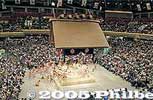
More people than the real tournamentAbout 8,000 people took time out from their Golden Week holidays to see this official sumo practice of all sumo stables.
|
|

Shrine hall
|
|
|
|

Barrels of cold water in front of shrine
|
|

Yokozuna Deliberation Council membersIn the middle is Kitanoumi.
|
|

Barrels of cold water
|
|
|
|

The congregation gather on the steps and beat fan-shaped drums.
|
|

Sumo elders in the front row
|
|

Priests appear
|
|

Former yokozuna Taiho, Takanosato, Kotozakura, and Wakanohana watch intently.
|
|

Way to Kokugikan. The guarded side gate on the right is for sumo wrestlers.
|
|
|

Asashoryu greets the council upon entry
|
|

Taiko drum tower
|
|
|

Asashoryu sips water offered by Ozeki ChiyotaikaiAs soon as Asashoryu entered the arena, many wrestlers went up to him to offer water as a show of respect.
|
|
|

Taiko drum tower
|
|
|

Asashoryu and TochiazumaAfter offering water, Tochiazuma shares a laugh with the yokozuna.
|
|

The 25th Asakusa Yabusame horseback archery was held on April 21, 2007 at Sumida Park.
|
|

Sumo wrestler banners
|
|

Chanting prayers
|
|

JR Ryogoku Station platform for the Sobu Line.
|
|
|

Parallel to Sumida River, the archery course is straight and narrow, stretching from the Tobu Line bridge to Kototoi Bridge.
|
|
|

Sumo wrestler and sumo stable banners
|
|
|

Friends after allKyokushuzan chats with fellow Mongolian Asashoryu.
|
|

The course has three targets which the archers will shoot arrows at.
|
|

Kokugikan
|
|
|

JR Ryogoku Station 両国駅
|
|

Practice
|
|

Raised dirt along the archery course.
|
|

Kokugikan ticket office (right). Ticket prices range from 2,100 yen to 14,300 yen.
|
|

JR Ryogoku Station. This part of the station building is now a beer hall. The train station entrance has moved to the right of this.
|
|
|
|
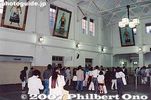
Old entrance to Ryogoku Station with a high ceiling and giant portraits of sumo wrestlers.
|
|

First, the horses, archers, and attendants parade along the entire course.
|
|

Kokugikan ticket office. Cheap tickets costing 2,100 yen are sold every day of the tournament, but sell out fast by noon or so.
|
|

Priests splash cold water over themselves at the Nose Myokenzan Betsuin in Sumida-ku, Tokyo
|
|

Me next please!!!The winner gets to decide who to wrestle next. The rikishi all beg to be picked.
|
|

Wooden targets
|
|
|

Present entrance to Ryogoku Station (during spring festival).
|
|

Gate to enter Kokugikan.
|
|

The Bulgarian (Kotooshu) on the left
|
|

Archer
|
|

At the gate, you might see a famous former wrestler (like former Takamiyama from Hawaii, now Stablemaster Azumazeki) taking your ticket.
|
|
|

Ryogoku Station exit. Only one sumo portait hangs here.
|
|

Yabusame archer
|
|

Map of Ryogoku. The Kokugikan sumo arena is north of the station, as well as the Edo-Tokyo Museum.
|
|

Front of Kokugikan. The wide stairs make it quick for many people to exit the building. It is a sleek, modern building with a spacious interior. The roof collects rainwater for use in the toilets.
|
|
|
|

Ready to pounce on the winner
|
|
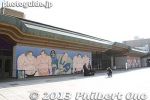
After you go through the ticket gate, the front of Kokugikan has two large murals.
|
|
|
|
|
|
|
|
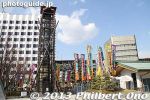
Taiko drum tower
|
|
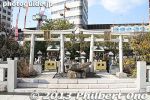
Two small shrines outside.
|
|
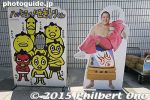
Pose with a cutout of popular rikishi Endo.
|
|

Pose with a cutout of popular rikishi Endo.
|
|
|
|
|

Filled with a water hose
|
|

Asashoryu joins in
|
|
|
|

Sumo wrestlers enter through a side entrance. Fans wait for their favorite wrestlers.
|
|
|
|

Deer skin
|
|

Entrance lobby. At the end of the lobby is a trophy showcase. On the last day of the tournament, the tournament winner will walk through here to his car for a victory parade amid a large crowd.
|
|
|

Both ozeki watch
|
|

Setting up the wooden target.
|
|

Side of lobby. (Passing out free calendar posters during Jan. tourney.)
|
|
|

Bull's eye. This is the third and last target along the course. It is quite difficult to hit all three targets, especially the last one.
|
|

Sumo mural in lobby.
|
|

In the entrance hall are life-size cutouts of the top wrestlers.
|
|
|

The horseback archer raises his bow and arrow high in the air as he nears the target.
|
|

Trophy case in lobby. This is the Emperor's Cup awarded to the tournament winner.
|
|

BreakAsashoryu took a water break between each practice bout.
|
|
|

Emperor's Cup. This is what all sumo wrestlers dream about.
|
|
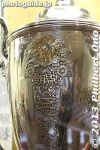
Closeup of Emperor's Cup.
|
|

I'm waiting...
|
|
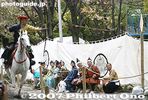
Arrow in mid-air. Asakusa Yabusame.
|
|

Nameplates of tournament winners on Emperor's Cup
|
|
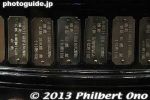
Closeup of nameplates of tournament winners on Emperor's Cup.
|
|

Old Nameplates of tournament winners that were on the Emperor's Cup.
|
|
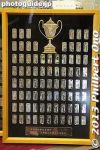
Old Nameplates of tournament winners that were on the Emperor's Cup.
|
|
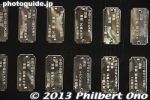
Closeup of old Nameplates of tournament winners that were on the Emperor's Cup.
|
|

Asashoryu gets thrown
|
|

Dead on!
|
|
|
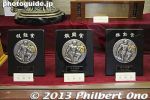
Plaques for the Three Outstanding Prizes (Technique, Outstanding Performance, and Fighting Spirit) awarded by two newspapers.Technique Prize (Gino-sho), Outstanding Performance (for most Yokozuna/Ozeki upsets, Shukun-sho), and Fighting Spirit (Kanto-sho).
|
|
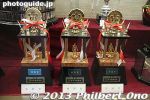
Trophies for the Three Outstanding Prizes (Technique, Outstanding Performance, and Fighting Spirit) from the Japan Sumo Association.Technique Prize (Gino-sho), Outstanding Performance (for most Yokozuna/Ozeki upsets, Shukun-sho), and Fighting Spirit (Kanto-sho).
|
|

A "darn it" look on his face
|
|

The archers return to the starting point.
|
|

The tournament winner receives numerous prizes from various organizations and companies.
|
|
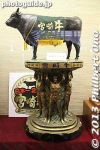
Prize from Miyazaki Prefecture.
|
|
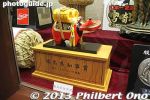
Prize from Fukushima Prefecture.
|
|
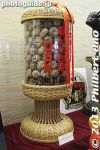
Mushrooms from Oita Prefecture.
|
|
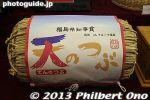
Another prize from Fukushima Prefecture.
|
|
|
|
|
|

Prime Minister's Cup on left, the middle is the President Chirac Award from France, and the glass on the right is a prize from the Czech Republic.President Chirac is a sumo fan. There is also a Czech wrestler in the lower division.
|
|

Butsuri keiko
|
|
|

Prize from the United Arab Emirates.
|
|

Edo-Tokyo Museum
|
|

Takamisakari for butsuri keikoEverybody cheered whenever he entered the ring.
|
|
|

Yokozuna statue
|
|

In the back on the left is a prize from Mexico and one from Hungary on the right. In the front on the left is a prize from Mongolia, middle is from NHK, and right is from China.
|
|
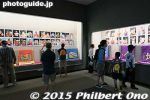
Sumo museum
|
|

Asashoryu exchanges a few wordsAfter the practice was over at 11 am, the sole yokozuna went over to the council.
|
|
|

Shop selling sumo goods.
|
|

Sumo Museum. Open only during tournament days. Free admission.The wall on the left show portraits of all the yokozuna in the modern era.
|
|
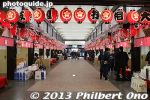
Sumo service entrance for groups.
|
|

Finish, everybody out please...
|
|

This is the second target at the center of the archery course. This is where the biggest crowd was.
|
|

Tatsunami-beya sumo stable.
|
|

Corridor and souvenir shops.A corridor encircles the arena.
|
|

Woman archer misses her target.
|
|

Sumo figurines.
|
|
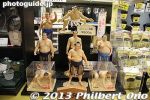
Sumo figurines.
|
|
|
|
|
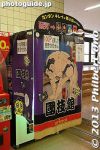
Print Club photo sticker booth.
|
|
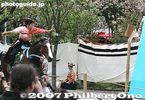
The crowd favorite was this high school girl. See the arrow pierce the wooden target.
|
|

Kokugikan Cafe snack bar
|
|
|

Bios and pictures of all sumo wrestlers in top Makunouchi division.
|
|

Local high school girl proudly rides back to the starting point amid applause.
|
|

The bios and pictures are categorized according to prefecture. All wrestlers who were/are active in the modern era are introduced. Two wrestlers from Shiga Prefecture: Kurama and Misugisato.
|
|

Woman archer
|
|

Non-Japanese sumo wrestlers who made it to Makunouchi Division. Four from USA (Hawaii), four from Mongolia, and one from Bulgaria (Kotooshu) as of 2006.
|
|
|

Bulgaria (Kotooshu)
|
|
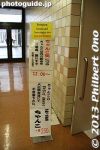
Entrance to the dining room for chanko-nabe. It's downstairs in the basement.
|
|
|
|

The chanko-nabe menu changes a few times during the tournament. The recipes are from various sumo stables.
|
|

This is the first target which is near the starting point. Love it when the target shatters like that.
|
|
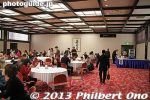
The banquet hall in the basement is used as a dining room during lunch time during tournaments. 大広間
|
|
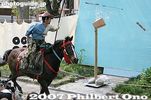
The wooden target boards have an envelope of confetti stuck on the back so it explodes when the target breaks apart.
|
|

I usually eat two bowls. Only 250 yen per bowl.
|
|
|

It is really good! Different flavors are offered during different days of the tournament. Top is shoyu (soy sauce) flavor, and bottom is salt flavor. Miso flavor is also offered.
|
|
|
|

Lecture classroom (previously used as a dining room for chanko-nabe during tournaments). 相撲教習所
|
|

Right after hitting the first target, the archer starts to pull out another arrow for the next target.
|
|

Next to the chanko dining room is a sumo ring for practice and deliberation exhibition matches.
|
|

The sign reads "Physical body, Technique, Heart." What you need to succeed in sumo.
|
|

Don't climb up any trees or step into the azalea bushes please. この叔父、つつじに入っちゃダメですよ。
|
|
|

Door to arena.
|
|
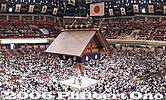
Panorama shot of sumo arena during a sumo tournament. There are two levels.
|
|

This is the lower level with zabuton box seats costing over 10,000 yen.
|
|

Box seats. Cramped space for four people.
|
|

Box seat for two.
|
|

Sumo ring and suspended roof (no pillars).
|
|

Shinto-style roof. If the house is full, the "Full House" banners are rolled down above the roof. (Now rolled up.)
|
|

Kiyosu-bashi Bridge over the Sumida River, Important Cultural Property 清洲橋 国の重要文化財
|
|
|

Upper level and VIP booth.
|
|

VIP booth or "Royal Box" where the Emperor and Empress (or Crown Prince and Princess) or head of state watch sumo.
|
|

Upper level seats.
|
|

Upper level and giant sumo portraits of 32 past tournament winners. As of Jan. 2012, there are no portraits of Japanese sumo wrestlers. Only foreigners.
|
|

Gate to Eko-in temple where early sumo tournaments were held. The temple was originally built in 1657 for the repose of over 100,000 people who died in the Great Fire of Meireki (Furisode Fire). 回向院
|
|

Giant portrait of Yokozuna AkebonoThese are B/W photographs painted over with oil.
|
|

Sumo monument in Eko-in temple. Sumo was first held here in 1768. 力塚
|
|

Giant portrait of Yokozuna Takanohana
|
|

Sumo monument in Ekoin temple. Sumo matches were held here regularly from 1833 to 1909 when the Kokugikan sumo stadium was built.
|
|

Giant portrait of Yokozuna Musashimaru
|
|

Memorials for those who died in maritime disasters.
|
|

Giant portrait of Yokozuna Asashoryu
|
|
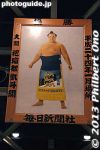
Giant portrait of Baruto
|
|
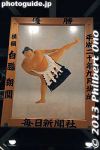
Giant portrait of Yokozuna Hakuho
|
|
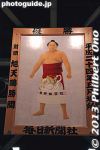
Giant portrait of Kyokutenho
|
|
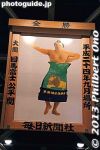
Giant portrait of Harumafuji
|
|
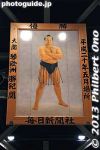
Giant portrait of Ozeki Kotooshu.
|
|

The temple has many other memorials and monuments.
|
|

Sumo scoreboard. The names of all the wrestlers are displayed in the order of the sumo matches (from right to left). The winner is indicated with a red lamp. Names of sumo wrestlers absent from the tournament (due to injury, etc.) are listed on the far le
|
|
|

Cemetary
|
|
|
|

The temple itself looks so modern and ordinary that it does not look like a temple.
|
|

Pet memorial, Eko-in
|
|

Pet memorial, Eko-in temple.
|
|

Site of Lord Kira's Estate or Honjo Matsuzaka-cho Park. Lord Kira was the villain in the famous Chushingura vendetta. 吉良邸跡・本所松坂町公園
|
|

This little park was purchased in 1934 by locals and donated to Tokyo to mark the site of Kira's estate. Free admission.
|
|

Marker for the Ako retainers' avenging their Lord who was forced to commit seppuku when he attacked Lord Kira at Edo Castle.
|
|

Inside the park is an Inari Shrine.
|
|

Matsuzaka Inari Shrine. On the right is a small, roofed stone monument engraved with the names of 20 of Kira's samurai who died during the attack. The stone monument was built by a local shopkeeper.
|
|

The shaded part of the map shows the area of the original estate and the black square shows the area of this park. It was a huge estate.
|
|
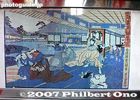
The walls inside have panels such as this one. Painting depicting Lord Asano's attack on Lord Kira at Edo Castle.
|
|
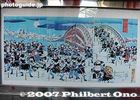
Painting depicting the retainers proceeding to Ryogoku to get Kira's head.
|
|

Sumo Photo Museum 相撲写真資料館
|
|

Next to a portrait studio is a small garage with sumo photos on the walls.
|
|

Inside Sumo Photo Museum
|
|

Sumo Photo Museum
|
|
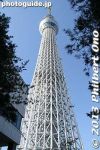
Finally went up Tokyo Skytree for the first time in Sept. 2013. I waited for a clear weekday and went early in the morning.
|
|
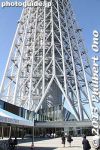
You can either buy a ticket at the door or buy a reserved ticket for a specific day via their Website. Visiting Tokyo Skytree on snowy days can be dangerous. Clumps of snow clinging to the struts are known to fall to the ground.
|
|

It's much cheaper to visit Skytree on your own instead of going on a typical bus tour. But a bus tour may exempt you from a long wait to go up since they have their own reserved tickets for a specific time.
|
|
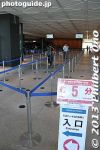
The least crowded time is weekday mornings between 8 am to 10 am. I got there at 9:30 am on a Friday and was happy to see no line to buy a ticket (2000 yen) to go up.
|
|
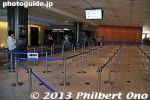
The problem with buying a reserved ticket for a specific day is that you won't know what the weather will be like that day. It's not worth going up on a cloudy/rainy day.Low clouds can easily cover the lookout decks and all you may see is cloud white. They also close the tower on windy/stormy days.
|
|

Tokyo Skytree ticket counter. Empty on weekday mornings from 8 am to 10 am.
|
|
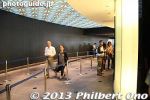
I went from 0 to 350 meters above the ground in less than 10 min. There are four elevators.
|
|

Each elevator has a design based on one of the four seasons. I went inside the summer elevator with a fireworks design. The elevator is very fast going up.Part of the elevator door is also transparent. Close your eyes or look away if you start to feel sick/dizzy. Please don't vomit in the elevator.
|
|
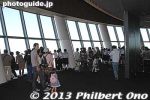
The first/lower observation deck is called the Tembo Deck.
|
|

The exposed struts inside the observation deck are padded so you don't crack your head when you bump into it. Lonely people who don't have anyone to hug could hug one of these. It's soft enough.
|
|
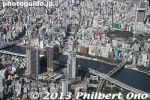
Stunning views. Sumida River.
|
|
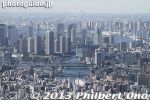
I saw one school girl here who looked very nauseous (likely threw up in the bathroom) with a friend rubbing her back.
|
|
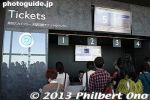
Here, you can buy another ticket for 1000 yen to go up further by 100 meters to the higher lookout deck called the Tembo Galleria, 450 meters above ground.
|
|
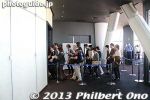
The line for that ticket was also very short before 10 am. Elevator to go higher.
|
|

The higher observation deck called Tembo Galleria has a unique design with a spiraling walkway called the Skywalk.
|
|
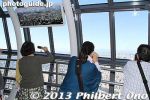
The Skywalk is not recommended if you fear heights.
|
|

The Skywalk can get quite warm on sunny days.
|
|
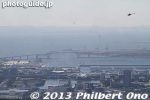
Gateway Bridge
|
|
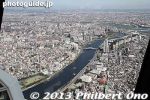
Views from the Skywalk.
|
|
|
|
|
|
|
|
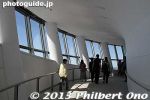
Going further up.
|
|
|

Ryogoku
|
|
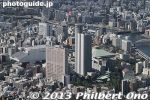
Ryogoku
|
|
|
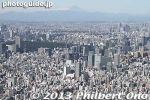
On a clear day, the views are marvelous, with Mt. Fuji (upper right) and many Tokyo landmarks visible.
|
|
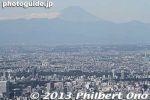
Mt. Fuji as seen from Tokyo Skytree.
|
|
|
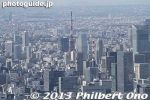
Tokyo Tower
|
|
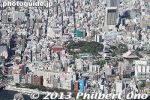
Asakusa
|
|
| 1248 files on 5 page(s) |
1 |
 |
 |
|